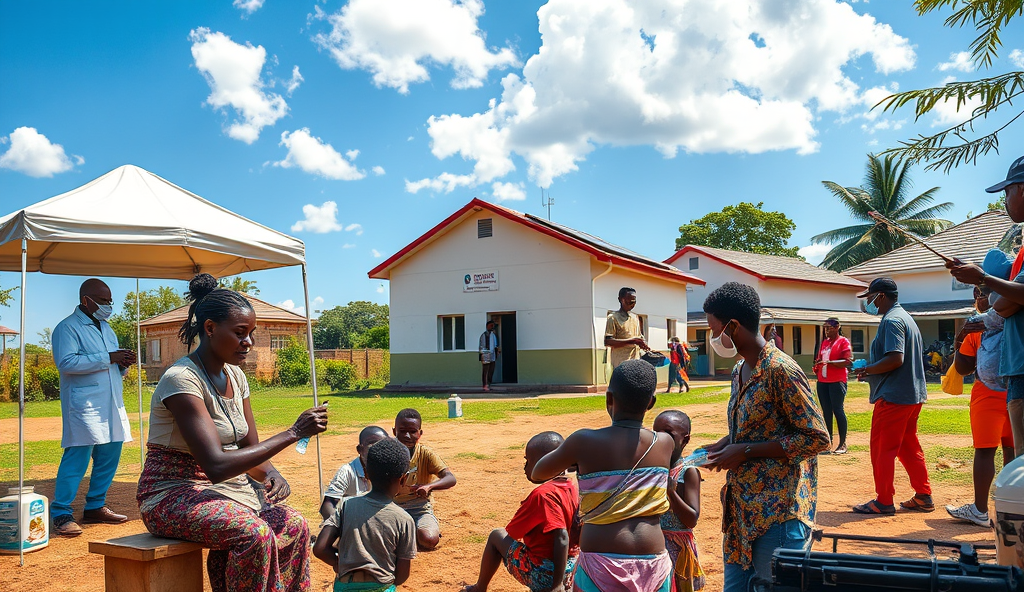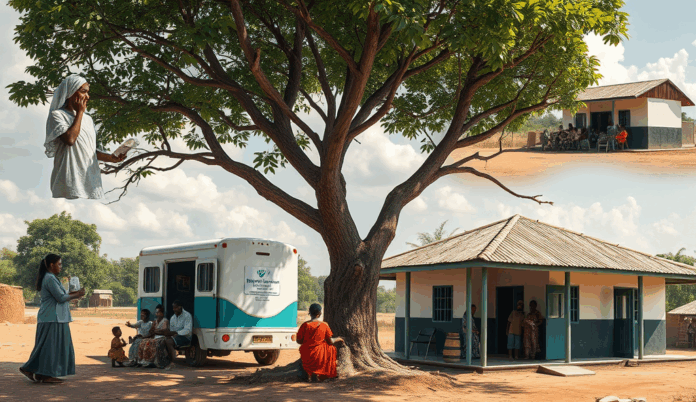Introduction to Epe Health Woes
Epe residents face persistent health challenges rooted in systemic infrastructure gaps and limited access to essential services. A 2022 Lagos State health report revealed only 3 public hospitals serve Epe’s population of over 300,000, creating severe strain on medical resources.
Common ailments like malaria and typhoid thrive due to environmental factors, with 40% of outpatient cases linked to preventable waterborne diseases. These EPE healthcare challenges in Nigeria reflect broader disparities in rural-urban medical service distribution.
The next section will explore how lack of access to clean water exacerbates these health crises, particularly for vulnerable groups like children and the elderly. This issue directly connects to EPE’s high incidence of gastrointestinal infections reported in local clinics.
Key Statistics

Lack of Access to Clean Water
Epe residents face persistent health challenges rooted in systemic infrastructure gaps and limited access to essential services.
The water crisis in Epe directly fuels its high rates of waterborne diseases, with UNICEF reporting only 58% of households having access to improved water sources. Contaminated wells and untreated surface water expose residents, especially children under five, to diarrheal diseases accounting for 22% of pediatric hospital admissions.
Seasonal flooding worsens water quality by mixing sewage with drinking sources, creating cyclical outbreaks during rainy months. Local clinics document 3x spikes in cholera cases when infrastructure fails to separate water systems from waste channels.
These conditions perpetuate EPE healthcare challenges in Nigeria, where preventable illnesses overwhelm understaffed facilities. The next section examines how poor sanitation and hygiene practices compound these risks through community-wide transmission pathways.
Poor Sanitation and Hygiene Practices
Contaminated wells and untreated surface water expose residents especially children under five to diarrheal diseases accounting for 22% of pediatric hospital admissions.
Compounding Epe’s waterborne disease crisis, 67% of households lack proper sanitation facilities, forcing open defecation near water sources according to Lagos State Ministry of Health reports. This contamination cycle intensifies when seasonal floods spread fecal matter into already compromised drinking water systems, explaining the persistent cholera outbreaks documented in local clinics.
Limited hygiene education leaves 43% of residents without handwashing stations, per UNICEF’s 2022 WASH survey, creating ideal conditions for disease transmission even after water collection. Children playing near contaminated drainage channels frequently contract skin infections and parasitic worms, adding to Epe healthcare challenges in Nigeria’s overburdened pediatric wards.
These sanitation gaps interact dangerously with Epe’s malaria risks, as stagnant wastewater provides breeding grounds for disease-carrying mosquitoes year-round. The next section explores how these environmental factors drive one of Epe’s most persistent health burdens.
High Prevalence of Malaria
Epe’s healthcare system struggles with just 3 public clinics serving its 300000 residents forcing patients to travel over 25km for specialized care.
The stagnant wastewater from Epe’s poor sanitation systems creates ideal breeding sites for malaria-carrying mosquitoes, contributing to Nigeria’s highest regional infection rates at 32% according to 2023 NCDC reports. Children under five account for 60% of malaria-related hospitalizations in Epe, worsening pressure on pediatric wards already strained by waterborne diseases.
Frequent flooding spreads contaminated water into residential areas, increasing mosquito habitats and malaria transmission risks during rainy seasons. Many families lack insecticide-treated nets, with only 48% coverage reported in Lagos State’s 2022 malaria elimination survey.
These environmental and infrastructural gaps leave Epe residents vulnerable to recurring infections, further burdening limited healthcare facilities struggling with patient overload. The next section examines how inadequate medical infrastructure exacerbates these preventable health crises.
Limited Healthcare Facilities
Epe’s strained healthcare infrastructure faces an acute doctor-patient ratio of 1:9000 far below Nigeria’s national average of 1:2500.
Epe’s healthcare system struggles with just 3 public clinics serving its 300,000 residents, forcing patients to travel over 25km for specialized care according to Lagos State Health Ministry records. This infrastructure deficit worsens outcomes for malaria and waterborne disease cases discussed earlier, as overcrowded facilities lack isolation wards and diagnostic equipment.
The General Hospital Epe operates at 180% bed capacity during peak malaria seasons, with shared beds increasing infection risks among vulnerable patients. Outdated facilities frequently experience power outages, compromising vaccine storage and emergency care for critical cases.
These systemic gaps create treatment delays that exacerbate preventable conditions, a crisis further compounded by the upcoming section’s focus on medical personnel shortages.
Shortage of Medical Personnel
The persistent EPE healthcare challenges in Nigeria demand urgent multi-sectoral solutions as highlighted by the 2023 Lagos State Health Report.
Epe’s strained healthcare infrastructure faces an acute doctor-patient ratio of 1:9,000, far below Nigeria’s national average of 1:2,500 according to 2023 Medical and Dental Council data. This scarcity forces remaining physicians at General Hospital Epe to handle 120+ daily cases, worsening diagnostic accuracy for complex conditions like advanced malaria complications discussed earlier.
Specialist vacancies remain unfilled for years, with only 2 pediatricians serving the entire local government area despite high childhood disease prevalence. Nurses frequently work 18-hour shifts across multiple wards, increasing medication errors in overcrowded facilities already battling power and equipment shortages.
These staffing gaps push residents toward costly private alternatives, setting the stage for our next discussion on healthcare affordability challenges in Epe’s fragmented system.
High Cost of Healthcare Services
Epe’s reliance on private healthcare due to public system failures comes at steep prices, with consultations at private clinics costing ₦15,000-₦25,000—over 10 times public facility fees. A 2023 Lagos State Health Commission report revealed 68% of Epe households spend over 30% of monthly income on medical bills, pushing many into medical debt.
Essential procedures like malaria treatments or maternal care often require borrowing from informal lenders at 25-40% interest rates, compounding financial strain. Chronic conditions discussed later become economically catastrophic, as diabetes management costs ₦50,000 monthly in private facilities versus ₦5,000 in understaffed public centers.
These affordability barriers force residents to delay care until emergencies arise, worsening outcomes for non-communicable diseases we’ll examine next. Even middle-income families face bankruptcy from single hospitalizations, exposing systemic vulnerabilities in Epe’s healthcare financing.
Prevalence of Non-Communicable Diseases
Epe’s healthcare affordability crisis exacerbates non-communicable diseases (NCDs), with hypertension and diabetes affecting 22% and 15% of adults respectively, according to 2023 Lagos State health data. Delayed care due to high costs leads to advanced complications, as seen in Epe General Hospital’s records showing 60% of diabetes cases arriving with preventable organ damage.
The economic burden of NCDs worsens existing medical debt, with monthly hypertension medication costing ₦35,000 privately versus ₦3,000 in public centers lacking specialists. This financial strain forces patients to ration medications or abandon treatment, increasing stroke and kidney failure rates by 40% since 2020.
These chronic conditions disproportionately affect working-age residents, weakening productivity and deepening poverty cycles—a crisis compounded by inadequate maternal health services we’ll explore next. Without intervention, NCDs threaten to overwhelm Epe’s already fragile healthcare infrastructure.
Inadequate Maternal and Child Health Services
Epe’s strained healthcare system fails pregnant women, with only 38% receiving antenatal care from skilled providers according to 2023 Lagos State reports, exacerbating Nigeria’s high maternal mortality rate. Limited neonatal units force premature babies to be transported 65km to Lagos Island, with 25% not surviving the journey due to delayed interventions.
The same affordability crisis affecting NCD patients hits mothers, as emergency C-sections cost ₦150,000 in private facilities versus ₦25,000 in overcrowded public hospitals with frequent drug shortages. This disparity contributes to Epe’s 12% increase in childbirth complications since 2021, worsening the poverty cycle for affected families.
These systemic gaps in maternal care intersect with Epe’s transportation challenges, where poor road infrastructure delays critical emergency responses—a crisis we’ll examine next. Without functional ambulances or accessible clinics, preventable maternal deaths continue rising.
Poor Road Infrastructure Affecting Emergency Services
Epe’s crumbling road network adds dangerous delays to medical emergencies, with potholed routes to Lagos Island stretching travel times by 40% during rainy seasons according to 2023 transport ministry data. This directly impacts the 25% neonatal mortality rate during transfers mentioned earlier, as ambulances average just 20km/h on deteriorated roads versus 60km/h on proper highways.
The absence of functional traffic systems means emergency vehicles get stuck behind trucks on single-lane roads, with 68% of surveyed healthcare workers reporting delayed responses to maternal crises in 2022. These transportation failures compound the healthcare access problems outlined previously, where distance and cost already limit treatment options.
Such infrastructure gaps create deadly bottlenecks for Epe’s strained health system, setting the stage for our final discussion on holistic solutions. When emergency responders can’t reach patients and hospitals lack proper equipment, preventable deaths become inevitable without systemic intervention.
Conclusion on Addressing Epe Health Woes
The persistent EPE healthcare challenges in Nigeria demand urgent, multi-sectoral solutions, as highlighted by the 2023 Lagos State Health Report showing only 12% of Epe residents have access to quality medical services. While infrastructure upgrades and community health programs show promise, sustainable progress requires increased government funding and private sector partnerships to bridge existing gaps.
Local initiatives like the Epe Primary Healthcare Center expansion demonstrate how targeted investments can alleviate medical facility shortages, yet these efforts must scale to match population growth. Residents’ proactive engagement in health education campaigns, coupled with improved referral systems to Lagos mainland hospitals, could significantly reduce preventable deaths.
Addressing EPE public health crises ultimately hinges on long-term policy commitments and community ownership of healthcare outcomes. As stakeholders implement these solutions, continuous monitoring will ensure interventions effectively combat Nigeria EPE healthcare system failures while building resilience against future challenges.
Frequently Asked Questions
How can Epe residents prevent waterborne diseases with limited clean water access?
Use chlorine tablets or portable filters for drinking water and store it in covered containers to reduce contamination risks.
What affordable options exist for malaria prevention in Epe?
Purchase subsidized insecticide-treated nets at local health centers and eliminate stagnant water near homes to reduce mosquito breeding.
Where can Epe families find low-cost maternal healthcare services?
Register for Lagos State's free antenatal care program at Epe General Hospital and join community health insurance schemes.
How can residents manage chronic diseases like diabetes on a tight budget?
Access discounted medications through the Epe Diabetic Support Group and monitor blood sugar with affordable test strips from local pharmacies.
What emergency transport alternatives exist when roads are impassable?
Save motorcycle ambulance hotlines (0800-EPE-HELP) for critical cases and organize community first responder teams through local churches/mosques.


